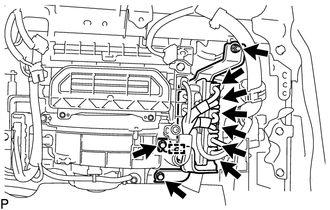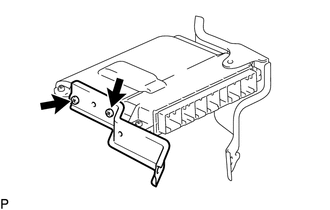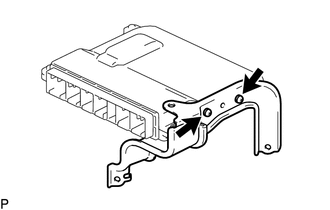Toyota Tacoma (2015-2018) Service Manual: Ecm
Components
COMPONENTS
ILLUSTRATION
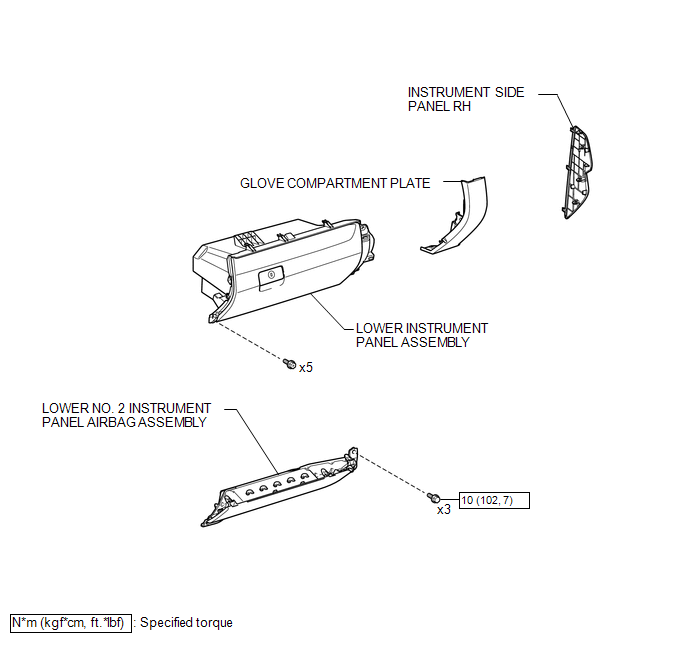
ILLUSTRATION
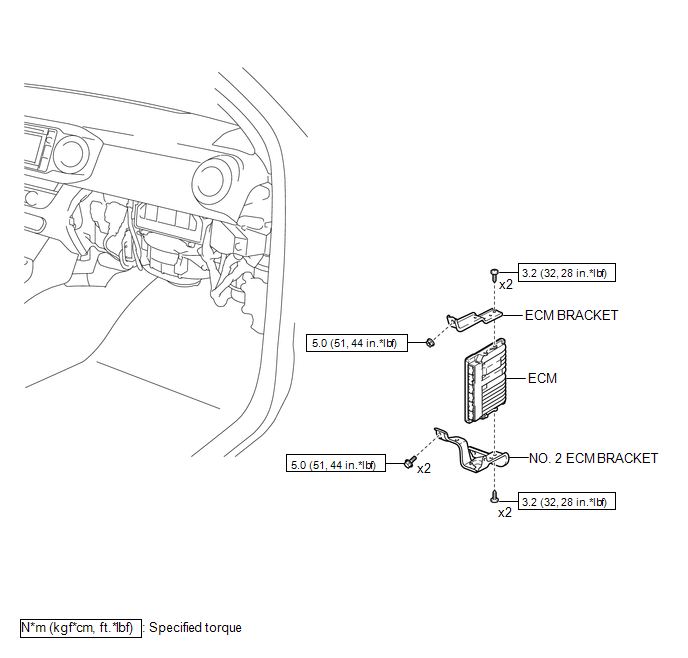
Installation
INSTALLATION
PROCEDURE
1. INSTALL NO. 2 ECM BRACKET
(a) Install the No. 2 ECM bracket to the ECM with the 2 screws.
Torque:
3.2 N·m {33 kgf·cm, 28 in·lbf}
2. INSTALL ECM BRACKET
(a) Install the ECM bracket to the ECM with the 2 screws.
Torque:
3.2 N·m {33 kgf·cm, 28 in·lbf}
3. INSTALL ECM
(a) Install the ECM to the instrument panel reinforcement assembly with the 2 bolts and nut.
Torque:
5.0 N·m {51 kgf·cm, 44 in·lbf}
(b) Connect the 6 connectors.
(c) Engage the clamp to install the wire harness.
4. INSTALL LOWER INSTRUMENT PANEL ASSEMBLY
.gif)
5. INSTALL LOWER NO. 2 INSTRUMENT PANEL AIRBAG ASSEMBLY
.gif)
6. INSTALL GLOVE COMPARTMENT PLATE
.gif)
7. INSTALL INSTRUMENT SIDE PANEL RH
.gif)
8. CONNECT CABLE TO NEGATIVE BATTERY TERMINAL
Torque:
5.4 N·m {55 kgf·cm, 48 in·lbf}
NOTICE:
When disconnecting the cable, some systems need to be initialized after the cable is reconnected.
Click here .gif)
9. PERFORM SRS WARNING LIGHT
(See page .gif) )
)
10. PERFORM INITIALIZATION
Click here .gif)
Removal
REMOVAL
PROCEDURE
1. PRECAUTION
CAUTION:
Be sure to read Precaution thoroughly before servicing (See page
.gif) ).
).
NOTICE:
After turning the ignition switch off, waiting time may be required before disconnecting
the cable from the negative (-) battery terminal. Therefore, make sure to read the
disconnecting the cable from the negative (-) battery terminal notices before proceeding
with work (See page .gif) ).
).
2. DISCONNECT CABLE FROM NEGATIVE BATTERY TERMINAL
NOTICE:
When disconnecting the cable, some systems need to be initialized after the cable is reconnected.
Click here .gif)
3. REMOVE INSTRUMENT SIDE PANEL RH
.gif)
4. REMOVE GLOVE COMPARTMENT PLATE
.gif)
5. REMOVE LOWER NO. 2 INSTRUMENT PANEL AIRBAG ASSEMBLY
.gif)
6. REMOVE LOWER INSTRUMENT PANEL ASSEMBLY
.gif)
7. REMOVE ECM
|
(a) Disengage the clamp to separate the wire harness. |
|
(b) Disconnect the 6 connectors.
(c) Remove the 2 bolts, nut and ECM from the instrument panel reinforcement assembly.
8. REMOVE ECM BRACKET
|
(a) Remove the 2 screws and ECM bracket from the ECM. |
|
9. REMOVE NO. 2 ECM BRACKET
|
(a) Remove the 2 screws and No. 2 ECM bracket from the ECM. |
|
 Crankshaft Position Sensor
Crankshaft Position Sensor
Components
COMPONENTS
ILLUSTRATION
Installation
INSTALLATION
PROCEDURE
1. INSTALL CRANKSHAFT POSITION SENSOR
(a) Apply a light coat of engine oil to the O-ring of the crankshaft position ...
 Engine Coolant Temperature Sensor
Engine Coolant Temperature Sensor
Components
COMPONENTS
ILLUSTRATION
Inspection
INSPECTION
PROCEDURE
1. INSPECT ENGINE COOLANT TEMPERATURE SENSOR
(a) Partially immerse the engine coolant temperature sensor in water and wa ...
Other materials:
Lost Communication with ECM / PCM "A" (U0100,U0125,U0126,U0129)
DESCRIPTION
The millimeter wave radar sensor assembly and ECM communicate with each sensor
and ECU via CAN communication.
If any malfunction is detected in a CAN communication circuit, one or more CAN
communication system DTCs are stored.
DTC No.
Detection Item
...
Terminals Of Ecu
TERMINALS OF ECU
1. ECM
Terminal No. (Symbol)
Wiring Color
Terminal Description
Condition
Specified Condition
E14-20 (TC) - E11-1 (E1)
G - W-B
DTC output signal
Ignition switch ON
...
Dtc Check / Clear
DTC CHECK / CLEAR
1. DTC CHECK
HINT:
When DTC B1650/23 is detected as a result of troubleshooting for the
airbag system, troubleshoot the occupant classification system.
Use the Techstream to read and clear DTCs, otherwise the DTCs cannot
be read and cleared.
(a) Check ...

